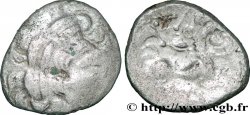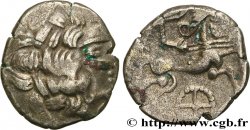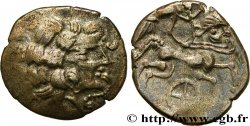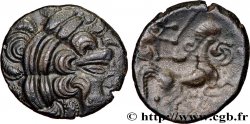bga_270845 - REDONES (Area of Rennes) Statère d’or à la cavalière armée et à la lyre - fourré et coupé en deux
无库存.
所有在网站上销售的产品 (2016)
价格 : 180.00 €
所有在网站上销售的产品 (2016)
价格 : 180.00 €
种类 Statère d’or à la cavalière armée et à la lyre - fourré et coupé en deux
日期: c. 200-150 AC.
材质 electrum
直径 15 mm
重量 3,73 g.
稀少度 R3
关于品相的说明
Monnaie avec une découpe assez nette, fortement enganguée d’une matière sombre et lisse. Avers et revers incomplets mais identifiable malgré une frappe un peu molle
正面
正面的文字 ANÉPIGRAPHE.
正面的说明书 Restes de tête laurée à droite.
背面
背面的文字 ANÉPIGRAPHE.
背面的说明书 Cavalière à droite, brandissant un bouclier et une épée ; entre les jambes du cheval, une lyre accostée d’une croisette bouletée.
评论
Ce statère semble pouvoir être rapproché du statère à la cavalière armée et à la lyre. Il semble être fourré, l’âme du métal étant particulièrement visible au niveau du coup de burin, à moins que le métal des dernières séries soit fortement allié de cuivre.
Si le phénomène de couper des monnaies en deux pour en faire des divisionnaires est bien attesté pour les monnaies de bronzes (as de Nîmes) et pour les potins, il nous semble que ce soit beaucoup plus rare pour les statères.
Comme pour le bga_270844, l'inexistence d’hémi-statère ou leur extrême rareté a pu motiver la découpe de cette monnaie. A moins qu’il s’agisse d’une démonétisation ou encore d’un morceau de métal destiné à la refonte....
Si le phénomène de couper des monnaies en deux pour en faire des divisionnaires est bien attesté pour les monnaies de bronzes (as de Nîmes) et pour les potins, il nous semble que ce soit beaucoup plus rare pour les statères.
Comme pour le bga_270844, l'inexistence d’hémi-statère ou leur extrême rareté a pu motiver la découpe de cette monnaie. A moins qu’il s’agisse d’une démonétisation ou encore d’un morceau de métal destiné à la refonte....








 对产品描述纠错
对产品描述纠错 打印
打印 分享我的选择
分享我的选择 提问
提问 Consign / sell
Consign / sell
 产品介绍
产品介绍



